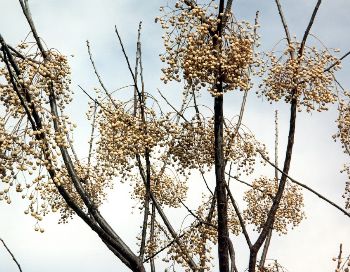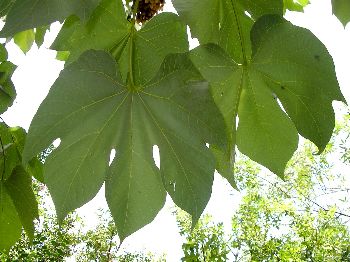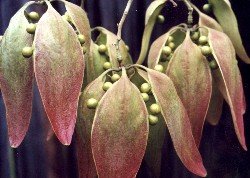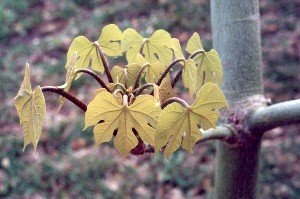Chinese Trees
by Valerie (May 12, 2000)
revised August 11, 2003
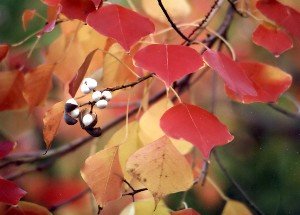 Having a rather eclectic garden, it is no surprise that we have quite a few plants from other areas and even other countries. Although a lot of native plants do well for us, the lure of the exotic is quite a temptation. The exotic plants often do just as well as, if not better than, the plants that grow wild in our area, and, indeed, some of the non-natives do grow wild. Having a rather eclectic garden, it is no surprise that we have quite a few plants from other areas and even other countries. Although a lot of native plants do well for us, the lure of the exotic is quite a temptation. The exotic plants often do just as well as, if not better than, the plants that grow wild in our area, and, indeed, some of the non-natives do grow wild.
We just happen to have three different species of trees that all have their origins in the Orient.
The Chinese tallow tree (Sapium sebiferum) is very common around here, and throughout the southern U.S. It grows quickly, has attractive heart-shaped leaves, and is very resistant to disease. The tallow trees in our yard never seem to grow as quickly as those in neighboring yards, but it could be that they just have too much competition from all the other trees. Still, they do grow and are capable of taking all sorts of abuse. I often use them as living trellises for favorite vines. In May, the flowers of the Chinese tallow smell wonderful and in the autumn, the leaves sometimes turn gold and red.
Another fast-growing tree is the chinaberry (Melia azedarach). We have a rather large one in our back yard that I planted about 17 years ago after digging it up in a vacant lot. It was less than one foot tall. Now it towers over the house and shades a large area. The leaves during the summer are dark green and glossy. The tree flowers in early April and the delightful smell of the tiny purple blossoms perfumes the entire yard. The blooms last for about two weeks. The clusters of yellow-coated seeds cling to the branches all winter, only dropping in the spring when new growth begins. The chinaberry is also called pride of India (because it is considered to be holy in India, Sri Lanka and Malaysia) and bead tree (as the hard pits of the seeds have a central hole and are used to make rosaries). The area under the chinaberry tree is littered with dropped seeds. When they first fall off, they are still covered by the sticky fruit, but eventually this wears away and the seed pits create a sort of gravelly ground cover. During the winter, flocks of cedar waxwings gorge themselves on the berries and our resident woodrats eat piles of the seeds, which they painstakingly extract from the hard shells, which then form large piles by the back fence. |
